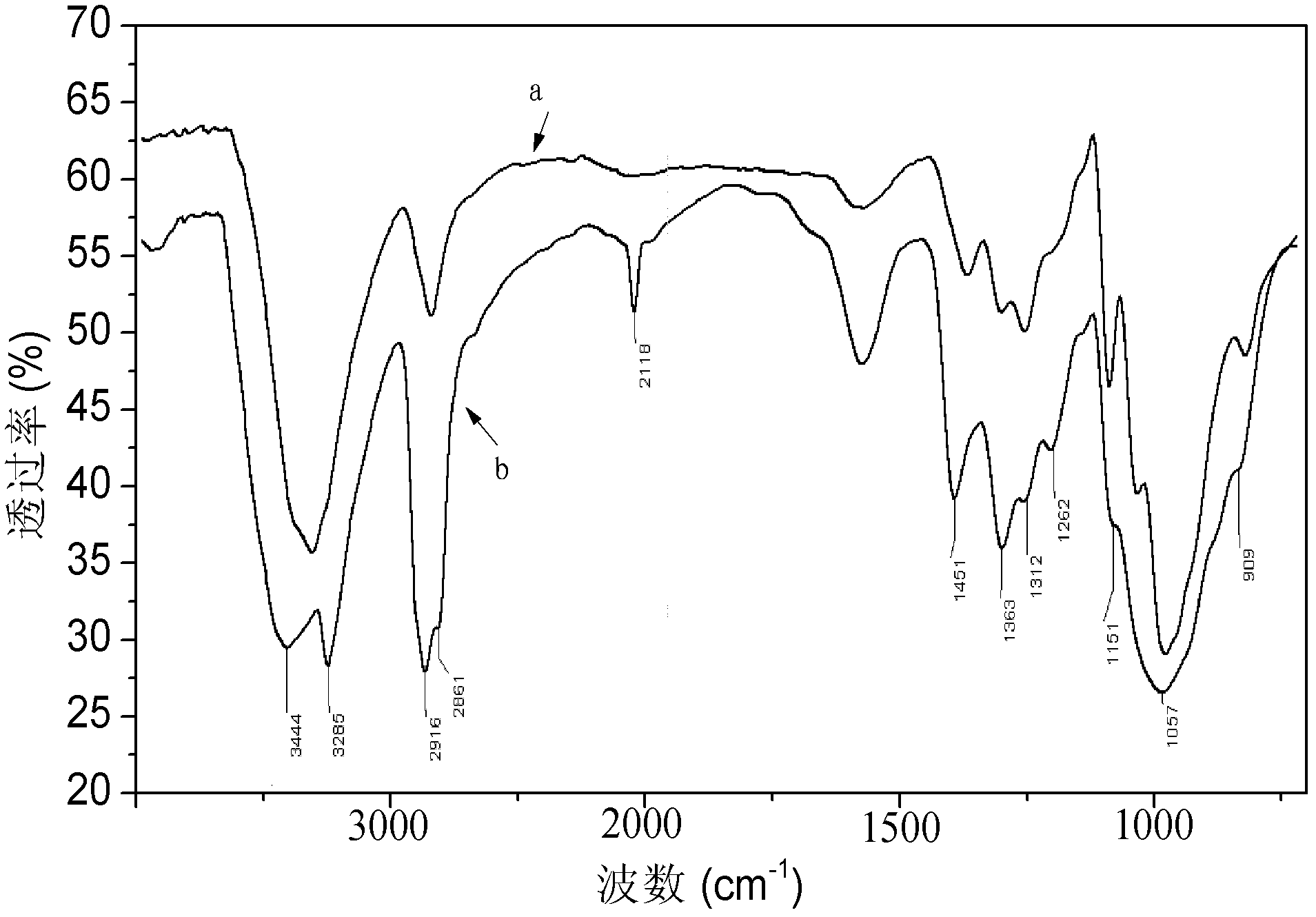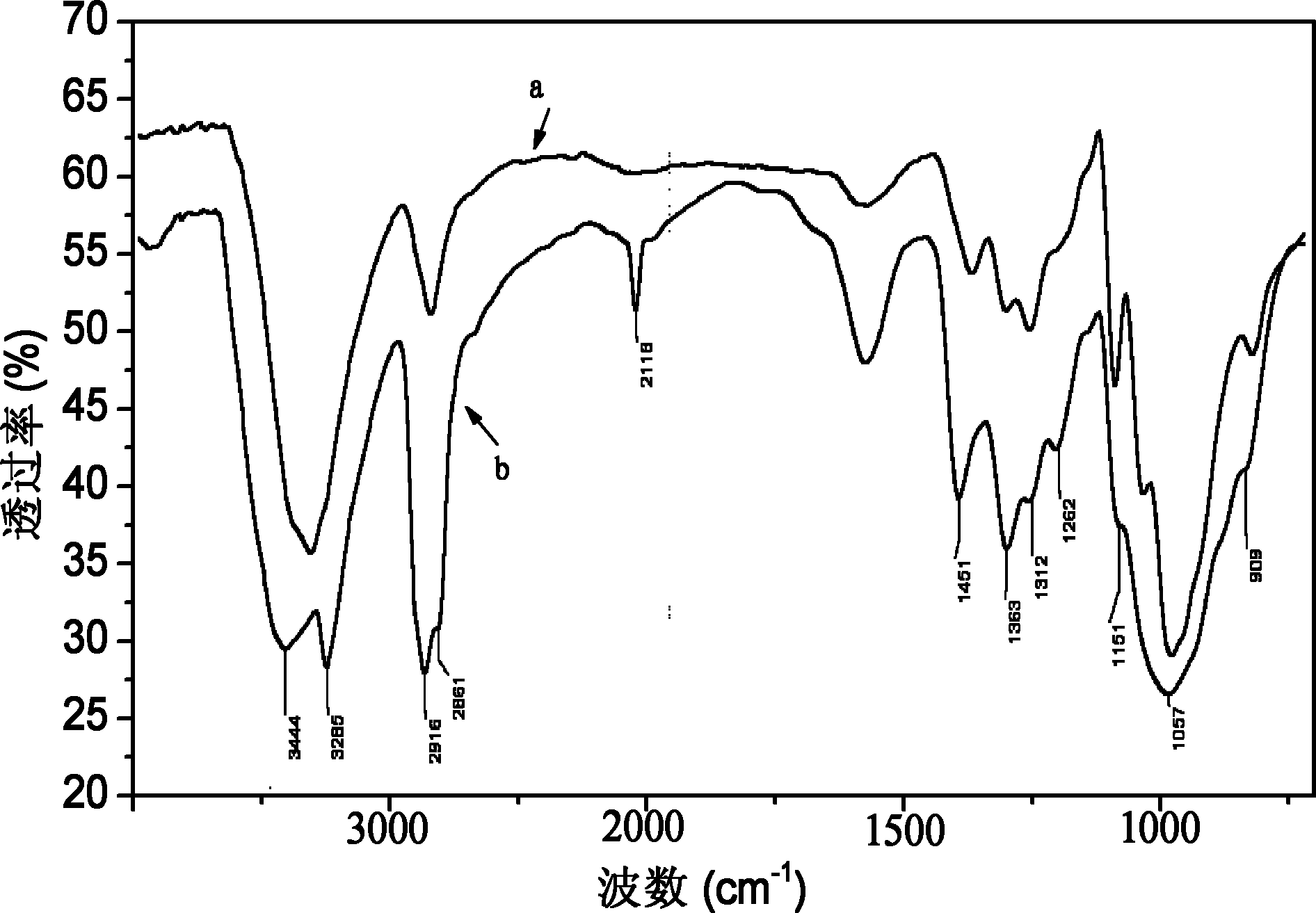Synthetic method of propyne cellulose
A synthesis method and cellulose technology, applied in the synthesis field of propyne cellulose, can solve the problems of cumbersome process and complicated reaction, and achieve the effects of uniform reaction, simple operation and high degree of product substitution
- Summary
- Abstract
- Description
- Claims
- Application Information
AI Technical Summary
Problems solved by technology
Method used
Image
Examples
Embodiment 1
[0033] A kind of synthetic method of propyne cellulose of the present embodiment comprises the following steps:
[0034] (1) Wetting: add α-cellulose to N,N-dimethylacetamide to moisten for 2 hours, and the temperature of moistening is 80°C; the mass of α-cellulose and N,N-dimethylacetamide The volume ratio is 1:200, and the unit is g / ml;
[0035] (2) Dissolution: Add LiCl to the solution obtained in step (1), continue to stir for 2 hours, completely dissolve α-cellulose, and maintain the temperature at 80°C; the mass-volume ratio of LiCl to N,N-dimethylacetamide 1:25~1:10, the unit is g / ml;
[0036] (3) Reaction:
[0037] (3-1) Lower the solution obtained in step (2) to room temperature, add NaH, and stir for 10 min; wherein the molar ratio of NaH to anhydroglucose units in α-cellulose is 1:1;
[0038] (3-2) Add chloropropyne at the following ratio: the molar ratio of anhydroglucose unit in chloropropyne to α-cellulose is 3:1, and stir at room temperature for 24 hours; the...
Embodiment 2
[0046] A kind of synthetic method of propyne cellulose of the present embodiment comprises the following steps:
[0047] (1) Moisturizing: add microcrystalline cellulose to N,N-dimethylformamide to moisten for 4 hours, and the temperature of embellishment is 120°C; the mass of microcrystalline cellulose and N,N-dimethylformamide The volume ratio is 1:20, and the unit is g / ml;
[0048] (2) Dissolution: Add LiCl to the solution obtained in step (1), continue to stir for 4 hours, completely dissolve the microcrystalline cellulose, and maintain the temperature at 120°C; the mass-volume ratio of LiCl to N,N-dimethylformamide 1:10, the unit is g / ml;
[0049] (3) Reaction:
[0050] (3-1) Cool the solution obtained in step (2) to room temperature, add LiOH, and stir for 30 minutes; wherein the molar ratio of LiOH to anhydroglucose units in microcrystalline cellulose is 1:1-6:1.
[0051] (3-2) First add propyne bromide according to the following ratio: the molar ratio of propyne bro...
Embodiment 3
[0058] A kind of synthetic method of propyne cellulose of the present embodiment comprises the following steps:
[0059] (1) Wetting: add pulp and paper to N,N-dimethylacetamide to moisten for 3 hours, and the temperature of moistening is 100°C; wherein the mass volume ratio of pulp and paper to N,N-dimethylacetamide is 1: 100, the unit is g / ml;
[0060] (2) Dissolving: add LiCl to the solution obtained in step (1), continue stirring for 3 hours, completely dissolve the pulp and paper, and maintain the temperature at 100°C; wherein the mass volume ratio of LiCl to N,N-dimethylacetamide is 1 : 18, the unit is g / ml;
[0061] (3) Reaction:
[0062] (3-1) Cool the solution obtained in step (2) to room temperature, add KOH, and stir for 20 minutes; wherein the molar ratio of KOH to anhydroglucose units in pulp and paper is 3:1.
[0063] (3-2) Add chloropropyne in the following ratio: the molar ratio of chloropropyne to the anhydroglucose unit in the pulp and paper is 9:1, and st...
PUM
 Login to View More
Login to View More Abstract
Description
Claims
Application Information
 Login to View More
Login to View More - R&D
- Intellectual Property
- Life Sciences
- Materials
- Tech Scout
- Unparalleled Data Quality
- Higher Quality Content
- 60% Fewer Hallucinations
Browse by: Latest US Patents, China's latest patents, Technical Efficacy Thesaurus, Application Domain, Technology Topic, Popular Technical Reports.
© 2025 PatSnap. All rights reserved.Legal|Privacy policy|Modern Slavery Act Transparency Statement|Sitemap|About US| Contact US: help@patsnap.com



